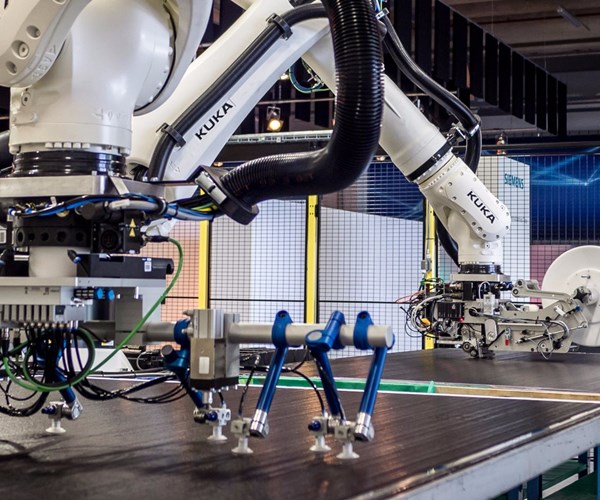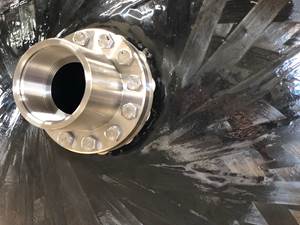Automated manufacturing solutions from Airborne
I had the chance recently to interview Marcus Kremers, chief technology officer of Airborne International (The Hague, Netherlands), who told me about his company’s growing smart automation initiatives for its customers.

Airborne is developing smart automation initiative for customers, like this pick and place robotic solution.
When you receive the December issue of ÂÌñÏ×ÆÞ magazine, you’ll see a Feature article on Industry 4.0, which looks at where the composites industry currently stands in relation to automated design and production. Because this topic is broad and growing, there just wasn’t enough room on the printed pages to include many of the innovations and companies involved. But I had the chance recently to interview Marcus Kremers, chief technology officer of Airborne (The Hague, Netherlands), who told me about his company’s growing smart automation initiatives for its customers.
If you don’t know Airborne, it is a composites part producer with about 120 employees focused primarily on space, aeronautics, maritime and the automotive industries. The maritime market sector (tidal turbine blades, ship propellers and other subsea composites) comes under the purview of Airborne Maritime (AEL in the UK), and a separate company, Airborne Oil and Gas (IJmuiden, Netherlands, Houston, TX, US and Kuala Lumpur, Malaysia), manufactures thermoplastic composite spoolable pipes for the oil and gas industry. The company is transforming itself into an automated solutions provider, using its more than 20 years of experience in advanced composite manufacturing.
For the past several years, says Kremers, Airborne has been developing a strategy to help its customers produce composites in faster, smarter, and automated ways: “We’re in the business of providing our customers high-end composite solutions, whether that means manufacturing the parts in our facility, or developing industrialization packages so that they can produce the parts themselves. Customers come to us with an idea — we help them realize that idea using our knowledge of composites and machine technology. Airborne’s focus is on high-end composite components, at high production rates at radically low conversion costs.”
It’s a three-pronged approach, according to the company, called “Prove and Move.” In the first phase, clients work with Airborne in a partnership to develop an efficient manufacturing method, and Airborne takes over part production. Phase 2 involves analysis of the part’s manufacturing process to identify quality-critical steps and develop a plan for automated and digital manufacturing, with input from equipment and software partners such as Kuka Robotics Corp. (Augsburg, Germany) and Siemens Nederland NV (The Hague, The Netherlands), respectively. Finally, production is shifted to the new, qualified automated line in Phase 3, either at Airborne’s facility, at the customer facility, or at a subcontractor’s manufacturing site. Here’s an Airborne video showing the various automation scenarios:
Says Kremers, “We have set up a Field Lab called “Digital Factory for Composites”, part of the Dutch Smart Manufacturing Initiative, to implement Industry 4.0 for composites with our partners Siemens, KUKA, TU Delft and more recently, materials supplier SABIC Innovative Plastics. This has really enabled us to better apply automation and digital manufacturing technology to our customers’ projects.”
A great example of Airborne’s approach to improving composite manufacturing productivity was recently announced (see the link to the CW story here: /news/airborne-introduces-automated-kitting-solutions). It’s a fully automated process for picking, sorting and placing of composite plies, a solution that can be fully integrated with any automated flat-table, conveyor-type cutting machine to reduce cost and labor time to convert composite rolls into sorted kits. The solution was introduced this past October at the AIRTEC 2017 trade show by Kremers.
He explains that the system is built around a KUKA robot and a camera system that’s integrated with the end effector, which can be a needle gripper or suction-cup type, depending on the customer’s need and material type. As the material is cut on the table within the nesting program, with the cutting head plotting a printed code on each piece, the robot takes up the pieces in accordance with the kitting system programming, and automatically sorts them at a sorting station to create the kits: “It’s one integrated cell. No human labor is needed to create the kit. The camera records the operation, and the code on each piece, and program does the work. It provides full traceability for each kit.”
He adds that the system has the capability of much more, such as nesting and kitting for material rolls, rather than just by part: “For example, if you are working on four different shipsets of parts, each of which uses some of Material A, it is possible to nest and cut all four shipsets with Material A as one batch, which saves tremendously on material waste, given the high cost of aerospace materials. The robotic system never loses track of which piece goes in which kit.” Kremers notes that the automated kitting system is advancing the adoption of advanced and dynamic nesting software strategies, which software providers such as Plataine (Waltham, MA, US) are promoting. As noted above, Airborne can perform the kitting for the customer, or can build and install the work cell in a customer’s facility.
Many more automated applications are in process, he says, although specifics can’t be announced yet: “We are working on an end-to-end automated process flow for thermoplastic tailored blanks for aerospace, and have a low-cost, robotic multi-functional ATL cell for the prepreg that also features pick & place for local patches and ultrasonic cutting, for example.” Watch CW for more on automated manufacturing from Airborne.
Related Content
Carbon fiber, bionic design achieve peak performance in race-ready production vehicle
Porsche worked with Action Composites to design and manufacture an innovative carbon fiber safety cage option to lightweight one of its series race vehicles, built in a one-shot compression molding process.
Read MoreLow-cost, efficient CFRP anisogrid lattice structures
CIRA uses patented parallel winding, dry fiber, silicone tooling and resin infusion to cut labor for lightweight, heavily loaded space applications.
Read MoreInfinite Composites: Type V tanks for space, hydrogen, automotive and more
After a decade of proving its linerless, weight-saving composite tanks with NASA and more than 30 aerospace companies, this CryoSphere pioneer is scaling for growth in commercial space and sustainable transportation on Earth.
Read MoreOtto Aviation launches Phantom 3500 business jet with all-composite airframe from Leonardo
Promising 60% less fuel burn and 90% less emissions using SAF, the super-laminar flow design with windowless fuselage will be built using RTM in Florida facility with certification slated for 2030.
Read MoreRead Next
Next-gen fan blades: Hybrid twin RTM, printed sensors, laser shock disassembly
MORPHO project demonstrates blade with 20% faster RTM cure cycle, uses AI-based monitoring for improved maintenance/life cycle management and proves laser shock disassembly for recycling.
Read MoreCutting 100 pounds, certification time for the X-59 nose cone
Swift Engineering used HyperX software to remove 100 pounds from 38-foot graphite/epoxy cored nose cone for X-59 supersonic aircraft.
Read MoreScaling up, optimizing the flax fiber composite camper
Greenlander’s Sherpa RV cab, which is largely constructed from flax fiber/bio-epoxy sandwich panels, nears commercial production readiness and next-generation scale-up.
Read More












